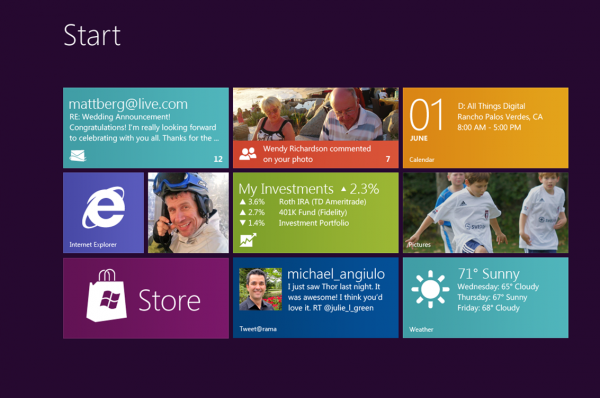Windows 8 launches October 26

Steven Sinofosky, president of the Windows & Windows Live division, announced the date during a Microsoft sales meeting this afternoon. Windows 8 follows other October launches -- its predecessor (Oct. 22, 2009) and XP (Oct. 25, 2001). Vista should have been as well, but Microsoft couldn't ship soon enough, unbelievably missing Christmas 2006.
Microsoft plans to release gold code the first week of August and make Windows 8 immediately available to volume-license subscribers. Everyone else will wait for Windows 8.
Windows Server 2012 release to manufacturing is expected around the same time, but Microsoft plans to make it widely available sooner, in September.
The Big Risk
Windows 8 is by far Microsoft's most ambitious version ever, and it's the riskiest undertaking, too. When viewed alongside Office 2013, Microsoft's new flagship operating system marks a dramatic directional change. After years of denial, Microsoft's leadership clearly accepts the transition from the PC to cloud-connected device era is well underway. For most of the Noughties, Microsoft acted like IBM during the last big computing era shift -- from mainframes to PCs -- and sought to preserve existing revenue streams and customers.
Risk-adverse Microsoft is suddenly big risk-taker, pushing a jarring but enticing new Windows user interface (Metro), releasing its own tablet (Surface), lowering the initial upgrade price ($39.99) and making a priority native code development (WinRT). Considering that large businesses compromise the majority of Microsoft customers, and they typically resist change of any kind, the company takes major risks indeed.
Microsoft needs Windows 8 to be the launch hoped for Vista. The 2007 "Wow" marketing campaign encapsulated what the company expected, but customers weren't wowed by Vista, which never gained much market acceptance. For last month, Net Applications puts Vista usage share at a paltry 7.29 percent. XP: 47.28 percent. Launch success is more than about sales but establishing positive perceptions -- that Microsoft is hip and Windows is cool again and just as much Apple. The fruit-logo company's iPad blindsided Microsoft, leading many PC upgraders to stick with the PC they have and augment their computing needs with the tablet. To that Microsoft needs an immediate response, and Windows 8 is it.
Continuing an accelerating trend, second-quarter PC shipments disappointed again, in the United States falling 10.6 percent year over year, according to IDC. The market needs something. Ultrabooks are a start, but Windows 8 -- and perhaps tablet-centric Windows RT even more -- should be it. Right now, there are few affordable Windows tablet alternatives to iPad or new Androids like Google's Nexus 7.
"Consumers are less interested in spending on PCs as [they] are other technology product and services, such as the latest smartphones and media tablets that they are purchasing", Mikako Kitagawa, Gartner principal analyst, says. "In the second quarter of 2012, the PC market suffered through its seventh consecutive quarter of flat to single-digit growth", Kitagawa says. Apple started selling the iPad eight quarters earlier. Surely that's no coincidence.
Seeding the Cloud
Microsoft risk-takers have amassed an amazing arsenal. If the company fails to maintain computing and informational relevance, it won't be for lack of trying. Microsoft pushes cloud services as core features for Windows 8 and Office 2013. If you look closely at the marketing collateral and FAQs for the Customer Preview released this week, Office 365 is front and center rather than the desktop suite. As I explained two days ago, the new version really isn't about applications but the cloud. It's a hugely ambitious undertaking, looking to fundamentally change how customers use Office (cloud plus applications) and pay for it (monthly subscription). Such colossal change is risky to the core, because too many individuals -- businesses more so -- resist change.
But combined with Windows 8, Office 2013 represents a cloud continuum as Microsoft puts connected devices ahead of traditional PCs while making them more part of the emerging device landscape. These devices empower people, by giving them access to more information at much lower cost, much like the PC did compared to mainframes a computing generation ago. Microsoft has been moving in this direction -- enabling access to data and information anytime, anywhere and on anything for some time -- but this product release cycle is a convergence across product lines. That's everything from Office to Windows to Windows Server to other Office System server software and more.
The approach also embraces the BYOD (bring-your-own-device) to work trend and could extinguish it as a Wild West routine. Employees bring their own gear in part because so many businesses are so risk-adverse -- that is slow to change. But BYOD creates IT management and security problems that Microsoft seeks to solve with this cloud converged release cycle.
Whether or not Windows 8 succeeds -- or any of the products in this dramatic release cycle -- is anyone's guess, and lots of people are doing just that. Here at BetaNews:
- Wayne Williams says "Windows 8 will flop"
- Randall C. Kennedy asks "What if Windows 8 fails?"
- Martin Brinkmann asks if "Windows 8 will be the new Vista?"
- Chris Wright says "Windows 8 is pointless for the enterprise"
- Jeremy Liu sees Windows 8 leading "Microsoft's road to redemption"
BetaNews readers sure seem determined to make Windows 8 a success: 45.65 percent of respondents to our recent poll plan to buy the software as soon as it's available.
Long before October 26, however, we'll have sense of how well Windows 8 may sell. By then, Microsoft's most important customers -- and hardest to please and least likely to upgrade -- will have had access to the software for nearly two months.
